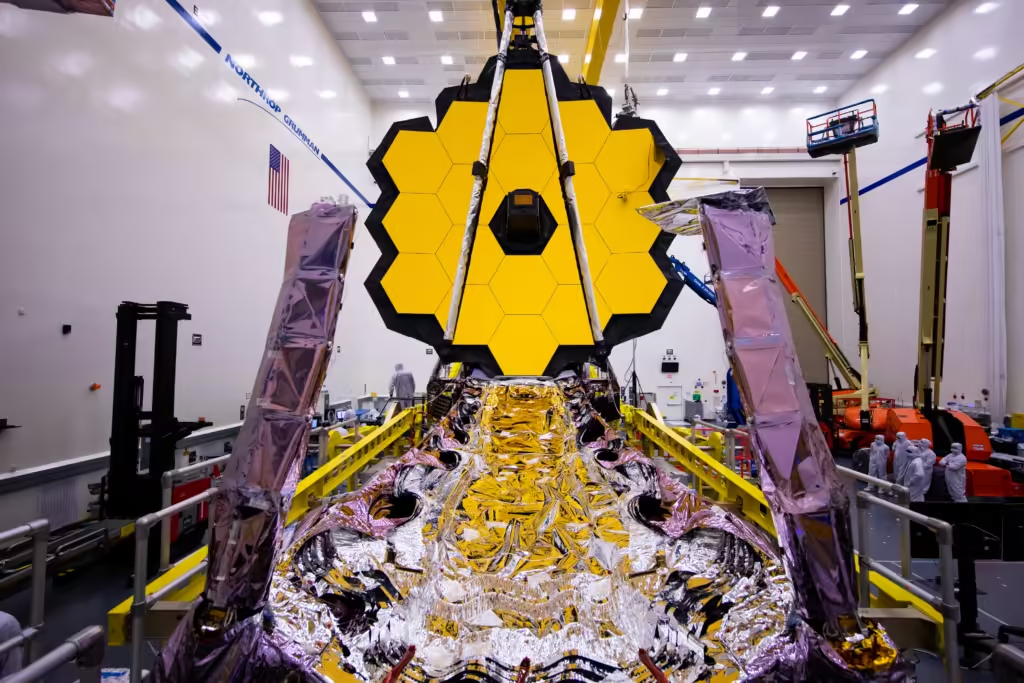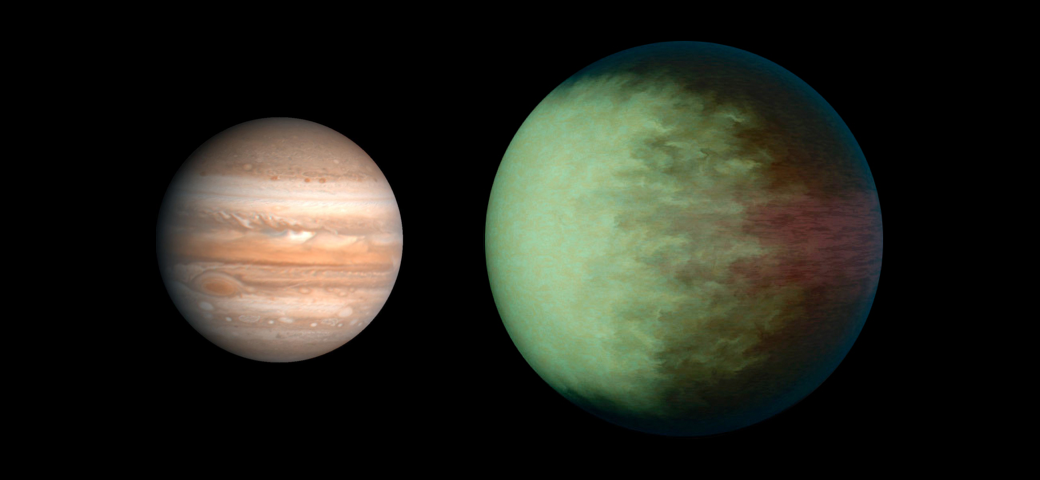Introduction
Humans have always wanted to explore the vast universe to understand where we come from, the mysteries of space, and our place in it. For more than 30 years, the Hubble Space Telescope has given us amazing pictures of distant galaxies and areas where stars are born, greatly increasing our knowledge of space. However, the James Webb Space Telescope (JWST), launched in 2021, pushes this exploration further.
The James Webb Space Telescope (JWST) has strong infrared abilities that let us see through cosmic dust. This helps us discover where stars and planets are born and capture light from the very first galaxies that formed after the Big Bang. While Hubble helped us understand what the universe is like now, JWST gives us a glimpse into its past. It helps us answer important questions about how galaxies form, how stars evolve, and if there could be life on faraway exoplanets. With JWST, we are about to enter a new age of space exploration, ready to uncover the greatest mysteries of the universe.
Why the James Webb Telescope is Different
The James Webb Space Telescope (JWST) is a huge advancement in space exploration technology. It has special features that let it see farther into the universe than older telescopes like the Hubble Space Telescope. Here’s a technical breakdown of the factors enabling this groundbreaking capability:
Infrared Vision:
What it Means: The JWST is mainly an infrared telescope, designed to detect light in the infrared spectrum, which is beyond what our eyes can see. Infrared light has longer wavelengths than visible light, allowing it to pass through thick clouds of dust and gas that usually block our view of space objects. The JWST has advanced infrared tools like the Near-Infrared Camera (NIRCam) and the Mid-Infrared Instrument (MIRI), which help it capture faint and distant objects with incredible clarity.
Why It Matters: Infrared vision is crucial for exploring parts of space that are hidden from view in visible light. For example, areas where stars are being born are often covered by thick clouds of gas and dust, but infrared light can pass through, giving us a clearer picture. Also, because the universe is expanding, light from the farthest galaxies gets stretched into the infrared spectrum, known as redshifting. This allows JWST to look at galaxies and objects from the early universe, only a few hundred million years after the Big Bang, helping us understand how the first stars and galaxies formed. JWST’s infrared abilities also allow it to study the atmospheres of planets outside our solar system, potentially finding signs that they could support life.
Larger Mirror:
Technical Detail: The JWST’s main mirror is a 6.5-meter gold-coated beryllium mirror made up of 18 segments. It is much bigger than Hubble’s 2.4-meter mirror. Once JWST reaches its operational point, located 1.5 million kilometers from Earth at the second Lagrange point (L2), this mirror unfolds and begins working.
Why It Matters: The size of a telescope’s mirror is important because it affects how much light it can collect. A larger mirror gathers more light, which is key to spotting faint, distant objects. JWST’s 6.5-meter mirror is over six times larger than Hubble’s, allowing it to detect objects billions of light-years away that we couldn’t observe before. The bigger mirror also helps produce clearer, sharper images of faraway galaxies, nebulae, and planets outside our solar system.
Advanced Cooling Systems:
The Science: To pick up faint infrared signals, JWST must stay extremely cold. It operates at about -233°C (40 K), close to absolute zero. It maintains this temperature with the help of a five-layer, tennis-court-sized sun-shield that blocks heat from the Sun, Earth, and Moon. This sunshield keeps the telescope cool enough to prevent its heat from interfering with its infrared sensors.
Why It Matters: Since infrared light is essentially heat, any warmth from the telescope or its surroundings could overpower the sensitive detectors, making it impossible to see faint cosmic objects. The cooling system and sun-shield work together to allow JWST to observe infrared signals with great accuracy. Without them, the telescope’s own heat would ruin the data, hiding the weak signals from distant galaxies and planets. The sun-shield also protects JWST from solar radiation, providing a stable environment for long, uninterrupted observations.
The JWST’s ability to explore space deeper than previous telescopes relies on its advanced technology. Its powerful infrared vision lets it see through cosmic dust and observe the early universe, while the large 6.5-meter mirror gathers more light than ever before. Its advanced cooling systems ensure that even the faintest infrared signals can be captured without interference from heat. These combined features make JWST a game-changer for understanding the universe, offering new insights into how stars, galaxies, and planetary systems are formed.

Page URL: https://commons.wikimedia.org/wiki/
Attribution: Northrop Grumman, CC BY 2.0 https://creativecommons.org/licenses/by/2.0, via Wikimedia Commons
How JWST Explores the Early Universe
The JWST’s ability to explore deeper into space than previous The James Webb Space Telescope (JWST) is uniquely designed to explore the early universe, giving us a glimpse into its infancy and the processes that shaped its evolution. Two key concepts explain how JWST achieves this remarkable feat: light travel time and its ability to study the Epoch of Reionization.
The Concept of Time Travel Time:
Explanation: In space, distances are so vast that we measure them by how long it takes light to travel. Light moves incredibly fast—around 300,000 kilometers per second (186,000 miles per second)—but even at this speed, it takes time to cover large distances in the universe. For example, light from the Sun takes about 8 minutes to reach Earth. When JWST looks at galaxies that are 13 billion light-years away, the light it sees has been traveling for 13 billion years. This means JWST is looking at those galaxies as they were 13 billion years ago.
Key Point: JWST isn’t just observing distant objects; it’s looking back in time. When it observes a galaxy 13 billion light-years away, it’s seeing that galaxy as it was 13 billion years ago, just a few hundred million years after the Big Bang. This ability to “look into the past” allows JWST to study the early universe, giving us a glimpse of some of the first stars and galaxies that ever formed.
Probing the Epoch of Reionization:
Definition: The Epoch of Reionization is an important time in the history of the universe that happened around 400 million to 1 billion years after the Big Bang. Before this era, the universe was dark and filled with neutral hydrogen atoms that absorbed light. When the first stars and galaxies formed, they emitted strong ultraviolet radiation, which gradually ionized the surrounding hydrogen gas. This process reionized the universe, making it clear for light to pass through and allowing galaxies to form as we know them today.
Scientific Impact: JWST is specially built to study this mysterious and not well-understood period in cosmic history. Its powerful infrared capabilities allow it to observe the very first galaxies that formed during the Epoch of Reionization. By examining the light from these early galaxies, JWST can help us understand how they formed, how they contributed to reionizing the universe, and how they evolved into the complex structures we see today.
JWST’s ability to explore this era will also help answer important questions: How did the first stars and galaxies form? What were their characteristics? How did they influence their surrounding cosmic environment? These discoveries will fill significant gaps in our understanding of how the universe evolved, giving us a clearer picture of how it changed from a dark, early state to the diverse collection of galaxies we see today.
Exoplanet Exploration
The James Webb Space Telescope (JWST) represents a significant step forward in the search for exoplanets—planets outside our solar system—by allowing us to study their atmospheres in detail. This ability is essential for assessing whether these planets could support life and for identifying the fundamental elements needed for life.

Page URL: https://commons.wikimedia.org/wiki/
Attribution: Chris Gunn, CC BY 2.0 https://creativecommons.org/licenses/by/2.0, via Wikimedia Commons
Characterizing Exoplanet Atmospheres:
Science Insight: One of JWST’s main scientific goals is to study the atmospheres of exoplanets using its advanced infrared instruments. Unlike earlier telescopes, JWST can detect infrared light, which enables it to observe the unique signatures of different molecules in these distant atmospheres. By capturing the light that passes through an exoplanet’s atmosphere during transits (when the planet moves in front of its host star), JWST can determine the chemical composition, temperature, and other important properties of the atmosphere.
Why It’s Important: Understanding exoplanet atmospheres is crucial for evaluating their potential to support life. Key molecules like water vapor, carbon dioxide, methane, and oxygen can indicate whether a planet might be habitable. For example, finding water vapor could suggest that liquid water might exist on the planet’s surface, while certain combinations of gases, such as methane and oxygen, could point to biological activity. By studying these atmospheres, scientists can look for bio-signatures—indicators of life—which are essential for answering the big question of whether we are alone in the universe.
Transit Spectroscopy:
Technical Detail: Transit spectroscopy is a valuable technique that JWST will use to study exoplanet atmospheres. When a planet passes in front of its host star, some of the starlight filters through the planet’s atmosphere before reaching JWST. By measuring the light from the star during this event, scientists can see how different wavelengths of light are absorbed or scattered by the atmosphere. This process creates a spectrum that shows the composition and characteristics of the atmosphere.
JWST’s Edge: JWST’s ability to detect infrared wavelengths gives it a major advantage in finding specific molecules in exoplanet atmospheres. Many important compounds, like water, carbon dioxide, and methane, have unique spectral signatures in the infrared range. JWST can identify these signatures even from faraway exoplanets, allowing for an in-depth analysis of their atmospheric chemistry. This capability will help scientists identify potentially habitable worlds and broaden our understanding of the diversity of planetary systems in the galaxy.
Conclusion
The JWST is set to address essential questions about the origins of the universe, how stars and planets form, and the possibility of life beyond Earth. By looking deeper into space and time than ever before, it will offer new insights into cosmic history, improving our understanding of how galaxies and planetary systems develop and change. Its studies of exoplanet atmospheres may also bring us closer to finding extraterrestrial life, potentially changing how we view life in the universe.
In essence, the JWST is more than just a telescope; it is a powerful tool in humanity’s quest to understand the universe and our place in it. It opens the door to groundbreaking discoveries in astrophysics and planetary science.

